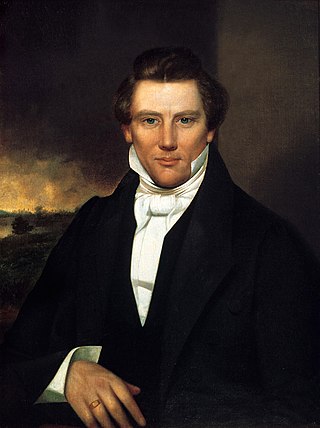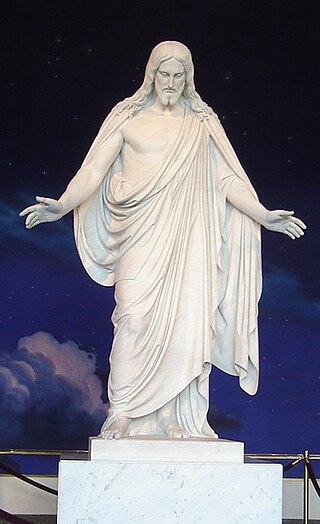
Mormonism is the theology and religious tradition of the Latter Day Saint movement of Restorationist Christianity started by Joseph Smith in Western New York in the 1820s and 1830s. As a label, Mormonism has been applied to various aspects of the Latter Day Saint movement, although there has been a recent push from the Church of Jesus Christ of Latter-day Saints to distance themselves from this label. A historian, Sydney E. Ahlstrom, wrote in 1982 that, depending on the context, the term Mormonism could refer to “a sect, a mystery cult, a new religion, a church, a people, a nation, or an American subculture; indeed, at different times and places it is all of these."
In Mormonism, the restoration refers to a return of the authentic priesthood power, spiritual gifts, ordinances, living prophets and revelation of the primitive Church of Christ after a long period of apostasy. While in some contexts the term may also refer to the early history of Mormonism, in other contexts the term is used in a way to include the time that has elapsed from the church's earliest beginnings until the present day. Especially in the Church of Jesus Christ of Latter-day Saints "the restoration" is often used also as a term to encompass the corpus of religious messages from its general leaders down to the present.

Oliver H. P. Cowdery was an American religious leader who, with Joseph Smith, was an important participant in the formative period of the Latter Day Saint movement between 1829 and 1836. He was the first baptized Latter Day Saint, one of the Three Witnesses of the Book of Mormon's golden plates, one of the first Latter Day Saint apostles and the Assistant President of the Church.

The Latter Day Saint movement is the collection of independent church groups that trace their origins to a Christian Restorationist movement founded by Joseph Smith in the late 1820s.

The Church of Christ was the original name of the Latter Day Saint church founded by Joseph Smith. Organized informally in 1829 in Upstate New York and then formally on April 6, 1830, it was the first organization to implement the principles found in Smith's newly published Book of Mormon, and thus its establishment represents the formal beginning of the Latter Day Saint movement. Later names for this organization included the Church of the Latter Day Saints, the Church of Jesus Christ, the Church of God, the Church of Christ of Latter Day Saints, and the Church of Jesus Christ of Latter Day Saints.

The Latter Day Saint movement is a religious movement within Christianity that arose during the Second Great Awakening in the early 19th century and that led to the set of doctrines, practices, and cultures called Mormonism, and to the existence of numerous Latter Day Saint churches. Its history is characterized by intense controversy and persecution in reaction to some of the movement's doctrines and practices and their relationship to mainstream Christianity. The purpose of this article is to give an overview of the different groups, beliefs, and denominations that began with the influence of Joseph Smith.
Thomas Baldwin Marsh was an early leader in the Latter-day Saint movement and an original member of the Quorum of the Twelve Apostles, who served as the quorum's first president in the Church of the Latter Day Saints from 1835 to 1838. He withdrew from the church in 1838, was excommunicated from it in 1839, and remained disaffected for almost 19 years. Marsh was rebaptized into the Church of Jesus Christ of Latter-day Saints in July 1857, but never again served in church leadership positions.

Blood atonement was a doctrine in the history of Mormonism still adhered to by some fundamentalist splinter groups, under which the atonement of Jesus does not redeem an eternal sin. To atone for an eternal sin, the sinner should be killed in a way that allows his blood to be shed upon the ground as a sacrificial offering, so he does not become a son of perdition. The largest Mormon denomination, the Church of Jesus Christ of Latter-day Saints, has denied the validity of the doctrine since 1889 with early church leaders referring to it as a "fiction" in spite of evidence to the contrary and later church leaders referring to it as a "theoretical principle" that had never been implemented in the LDS Church.

The salt sermon was an oration delivered on 17 June 1838 by Sidney Rigdon, then First Counselor in the First Presidency of the Church of Jesus Christ of Latter Day Saints, and frequent spokesman for Joseph Smith, the founder of the Latter Day Saint movement, against church dissenters, including Book of Mormon witnesses Oliver Cowdery, David Whitmer, and John Whitmer, and other leaders including W. W. Phelps. The Salt Sermon is often confused with Rigdon's July 4th oration.
The Mormon Reformation was a period of renewed emphasis on spirituality within the Church of Jesus Christ of Latter-day Saints, and a centrally-directed movement, which called for a spiritual reawakening among church members. It took place during 1856 and 1857 and was under the direction of church president Brigham Young. During the Reformation, Young sent his counselor, Jedediah M. Grant, and other church leaders to preach to the people throughout Utah Territory and surrounding Latter-day Saint communities with the goal of inspiring them to reject sin and turn towards spiritual things. During this time, some of the most conservative or reactionary elements of LDS Church doctrine came to dominate public discussion. As part of the Reformation, almost all "active" or involved LDS Church members were rebaptized as a symbol of their commitment. The Reformation is considered in three phases: a structural reform phase, a phase of intense demand for a demonstration of spiritual reform, and a final phase during which an emphasis was placed on love and reconstruction.

Within the Latter Day Saint movement, the "Articles of Faith" is a statement of beliefs composed by Joseph Smith as part of an 1842 letter sent to "Long" John Wentworth, editor of the Chicago Democrat, and first published in the Latter Day Saint newspaper Times and Seasons. It is a concise listing of thirteen fundamental doctrines of Mormonism. Most Latter Day Saint denominations view the articles as an authoritative statement of basic theology. Some denominations, such as the Church of Jesus Christ of Latter-day Saints, have adopted the articles as scripture. For some sects, the Articles of Faith are known collectively as "An Epitome of Faith and Doctrine".
Mormons have experienced significant instances of violence throughout their history as a religious group. In the early history of the United States, violence was used as a form of control. Mormons faced persecution and forceful expulsion from several locations. They were driven from Ohio to Missouri, and from Missouri to Illinois. Eventually, they settled in the Utah Territory. These migrations were often accompanied by acts of violence, including massacres, home burnings, and pillaging.
The Mountain Meadows Massacre was caused in part by events relating to the Utah War, an armed confrontation in Utah Territory between the United States Army and Mormon Settlers. In the summer of 1857, however, Mormons experienced a wave of war hysteria, expecting an all-out invasion of apocalyptic significance. From July to September 1857, Mormon leaders prepared Mormons for a seven-year siege predicted by Brigham Young. Mormons were to stockpile grain, and were prevented from selling grain to emigrants for use as cattle feed. As far-off Mormon colonies retreated, Parowan and Cedar City became isolated and vulnerable outposts. Brigham Young sought to enlist the help of Indian tribes in fighting the "Americans", encouraging them to steal cattle from emigrant trains, and to join Mormons in fighting the approaching army.
Mormon theology has long been thought to be one of the causes of the Mountain Meadows Massacre. The victims of the massacre, known as the Baker–Fancher party, were passing through the Utah Territory to California in 1857. For the decade prior the emigrants' arrival, Utah Territory had existed as a theocracy led by Brigham Young. As part of Young's vision of a pre-millennial "Kingdom of God," Young established colonies along the California and Old Spanish Trails, where Mormon officials governed as leaders of church, state, and military. Two of the southernmost establishments were Parowan and Cedar City, led respectively by Stake Presidents William H. Dame and Isaac C. Haight. Haight and Dame were, in addition, the senior regional military leaders of the Mormon militia. During the period just before the massacre, known as the Mormon Reformation, Mormon teachings were dramatic and strident. The religion had undergone a period of intense persecution in the American mid-west.

This is a chronology of Mormonism. In the late 1820s, Joseph Smith, founder of the Latter Day Saint movement, announced that an angel had given him a set of golden plates engraved with a chronicle of ancient American peoples, which he had a unique gift to translate. In 1830, he published the resulting narratives as the Book of Mormon and founded the Church of Christ in western New York, claiming it to be a restoration of early Christianity.

The following outline is provided as an overview of and a topical guide to the Church of Jesus Christ of Latter-day Saints.

The following outline is provided as an overview of and topical guide to the life and influence of Joseph Smith:









